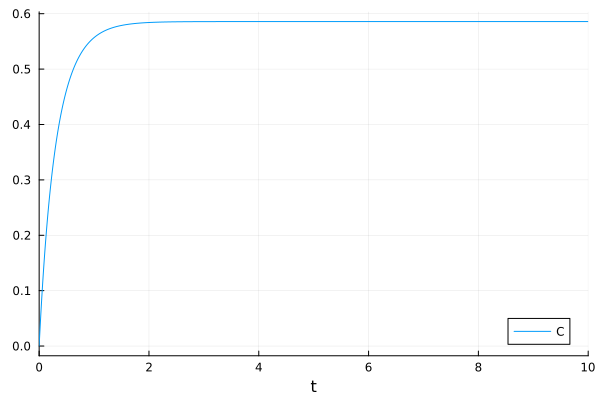Calalyst tips#
Conservation laws#
We can use conservation laws to eliminate some unknown variables.
For example, in the chemical reaction A + B <--> C, given the initial concentrations of A, B, and C, the solver needs to find only one of [A], [B], and [C] instead of all three.
using Catalyst
using ModelingToolkit
using DifferentialEquations
using Plots
rn = @reaction_network begin
(k₊, k₋), A + B <--> C
end
\[ \begin{align*}
\mathrm{A} + \mathrm{B} &\xrightleftharpoons[\mathtt{k_-}]{\mathtt{k.}} \mathrm{C}
\end{align*}
\]
Set initial condition and parameter values
setdefaults!(rn, [:A => 1.0, :B => 2.0, :C => 0.0, :k₊ => 1.0, :k₋ => 1.0])
Let’s convert it to a system of ODEs, using the conservation laws to eliminate two species, leaving only one of them as the state variable.
The conserved quantities will be denoted as Γs
osys = convert(ODESystem, rn; remove_conserved=true) |> structural_simplify
┌ Warning: You are creating a system or problem while eliminating conserved quantities. Please note,
│ due to limitations / design choices in ModelingToolkit if you use the created system to
│ create a problem (e.g. an `ODEProblem`), or are directly creating a problem, you *should not*
│ modify that problem's initial conditions for species (e.g. using `remake`). Changing initial
│ conditions must be done by creating a new Problem from your reaction system or the
│ ModelingToolkit system you converted it into with the new initial condition map.
│ Modification of parameter values is still possible, *except* for the modification of any
│ conservation law constants (Γ), which is not possible. You might
│ get this warning when creating a problem directly.
│
│ You can remove this warning by setting `remove_conserved_warn = false`.
└ @ Catalyst ~/.julia/packages/Catalyst/48wH3/src/reactionsystem_conversions.jl:456
\[ \begin{align}
\frac{\mathrm{d} A\left( t \right)}{\mathrm{d}t} &= \mathtt{k{_-}} \left( - A\left( t \right) + \Gamma_{2} \right) + \mathtt{k.} \left( - A\left( t \right) - \Gamma_{1} \right) A\left( t \right)
\end{align}
\]
Only one (unknown) state variable need to be solved
unknowns(osys)
1-element Vector{SymbolicUtils.BasicSymbolic{Real}}:
A(t)
The other two are constrained by conserved quantities
observed(osys)
\[\begin{split} \begin{align}
B\left( t \right) &= A\left( t \right) + \Gamma_{1} \\
C\left( t \right) &= - A\left( t \right) + \Gamma_{2}
\end{align}
\end{split}\]
Solve the problem
oprob = ODEProblem(osys, [], (0.0, 10.0), [])
sol = solve(oprob, Tsit5())
┌ Warning: Initialization system is overdetermined. 2 equations for 0 unknowns. Initialization will default to using least squares. To suppress this warning pass warn_initialize_determined = false. To make this warning into an error, pass fully_determined = true
└ @ ModelingToolkit ~/.julia/packages/ModelingToolkit/zfOUk/src/systems/diffeqs/abstractodesystem.jl:1291
retcode: Success
Interpolation: specialized 4th order "free" interpolation
t: 19-element Vector{Float64}:
0.0
0.06602162921791198
0.16167383723177658
0.27797398569864795
0.42472768210212675
0.5991542465684496
0.8069250399875878
1.0494129741596487
1.3328285260259545
1.6634553095820483
2.0523543727756204
2.514619744984259
3.073985028187367
3.7668739415643824
4.65256513049854
5.821585305489345
7.328825483832256
8.975283435170365
10.0
u: 19-element Vector{Vector{Float64}}:
[1.0]
[0.8836569748526829]
[0.7588242777314499]
[0.6540331462534721]
[0.5681302593629073]
[0.5062418977317176]
[0.46461886630918997]
[0.43937914557022106]
[0.42544919657534686]
[0.4186148714289667]
[0.4156790083953944]
[0.4146117644861058]
[0.4142972990536097]
[0.4142270387749867]
[0.4142160588486048]
[0.4142152933849376]
[0.4142196830866055]
[0.41425212965225616]
[0.4142262306892306]
You can still trace the eliminated variable
plot(sol, idxs=osys.C)

This notebook was generated using Literate.jl.
